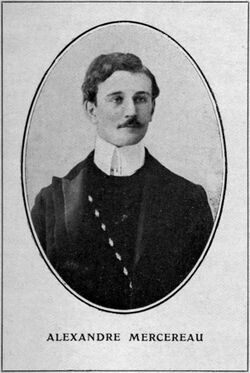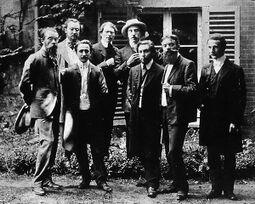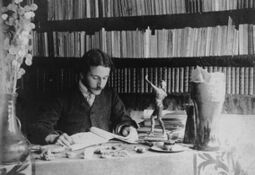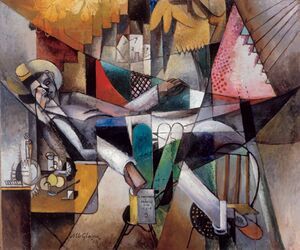Biography:Alexandre Mercereau
Alexandre Mercereau | |
|---|---|
 | |
| Born | Alexandre Mercereau de la Chaume 22 October 1884 Paris, France |
| Died | 1945 |
| Occupation | Poet |
| Literary movement | Symbolist poets |
Alexandre Mercereau (22 October 1888 – 1945) was a French symbolist poet and critic associated with Unanimism and the Abbaye de Créteil. He founded the Villa Médicis Libre, which helped impoverished artists and operated as charitable reformatory for delinquent teenagers.[1] Mercereau's work inspired the revolutionary artistic movement of the early 20th century known as Cubism.
Early life and career
Born Alexandre Mercereau de la Chaume, he signed his first texts Eshmer-Valdor, a pseudonym he quickly abandoned. In 1901, at sixteen years of age, Mercereau's first verses were published; poetry and criticism in Oeuvre d'art international. In 1904 he co-founded the magazine La Vie, where he became assistant editor, drama critic, and columnist.[2][3]
In 1905 he published Les Thuribulums affaissés, a book of verse that attracted much attention. At the same time, he co-founded the Association Ernest-Renan. In 1906 he organized the French section of Salon exhibition and literary review La Toison d'Or.[2]
In 1907 he published Gens de là et d'ailleurs. From 1907 to 1908 he co-founded and participated in the experience of the Abbaye de Créteil, a collective open to artists. Mercereau organized exhibitions of French artists in Moscow, Saint-Petersburg, Kiev, and Odessa. After World War I he published a pamphlet, L'Abbaye et le bolchevisme culturel (published by Eugène Figuière), in which he denounced the attitude of Georges Duhamel and Charles Vildrac. From 1910 he co-directed with Paul Fort the Parisian literary review Vers et Prose. In 1911 he created the literary section of the Salon d'Automne in Paris, called Comité d'initiative théâtrale, consisting of public lectures by emerging authors at the Théâtre de l'Odéon. He subsequently co-founded the Revue indépendante and La Rue, in addition to Vers et Prose.[2]
Mercereau was literary director at Jacques Povolozky & Cie publishing, director of Caméléon, a café littéraire in Montparnasse. In Histoire Contemporaine des Lettres Française de 1885 à 1914 (Eugène Figuière), Ernest Florian-Parmentier writes "... M. Mercereau seems endowed with all the qualities that lead almost inevitably to success.[4][5]
Abbaye de Créteil
The Abbaye de Créteil was a phalanstère utopian community founded during the fall of 1906 by Alexandre Mercereau, along with the poets René Arcos, Henri-Martin Barzun, Charles Vildrac, and the artist, theorist Albert Gleizes.[6] The movement drew its inspiration from the Abbaye de Thélème, a fictional creation by Rabelais in his novel Gargantua.
Albert Gleizes met the artists Berthold Mahn, Jacques d'Otémar and Josué Gaboriaud while in Amiens (1904), as well as the printer, Lucien Linard, who would run the printshop at the Abbaye de Créteil. At this time, the art critic Jean Valmy Baysse (and soon historian of the Comédie-Française), in collaboration with Alexandre Mercereau, René Arcos, Charles Vildrac and Georges Duhamel were invited to participate on a new journal, titled La Vie.[7]
Symbolist poet and writer Henri-Martin Barzun joined the group of writers and painters in 1905. Gleizes assisted in the formation of the Association Ernest Renan in December at the Théâtre Pigalle, in an attempt to counter the rise of militarist propaganda. In the process, publications and artwork tended towards a more popular and secular culture. Gleizes was in charge of the literary and artistic developments that organized poetry readings and street theatre.[7]
Mercereau, Gleizes and others throughout 1906 worked on a concept established by Charles Vildrac of creating a self-supporting community of artists. The motivation was to develop their art free of commercial considerations. In Créteil, a small village outside Paris, they invested a house and grounds. Barzun paid the rent for the first six months, financed with his small inheritance. Gleizes and Vildrac moved in during the month of December.[7] At the outset of 1907 the Abbaye de Créteil consisted of Gleizes, Arcos and Vildrac with his wife Rose, sister of Duhamel. Duhamel and Barzun joined the group periodically. The musician Albert Doyen, later to become known as founder of the Fêtes du Peuple also participated intermittently. In 1906 Mercereau travelled to Moscow, where he met a group of Russian symbolist and Art Nouveau artists called Голубая роза (Blue Rose). There worked on a magazine publication and helped organize the French section of a salon exhibition called La Toison d'Or (Golden Fleece, Золотое руно). Simultaneously, he worked as a correspondent for the Abbaye de Créteil.[7]
He returned to Paris in the Spring of 1907 with a Russian wife. At this time the Abbaye group supported itself through the printing (run by Linard and Gleizes) of high-quality material. The painters Berthold Mahn, Jacques d'Otémar and Henri Doucet visited periodically.[7]
A former student at the Académie Julian and a friend of Maurice Denis and Les Nabis, Henri Le Fauconnier was painting in a progressively geometric fashion. He exhibited his seascapes at the 1909 Salon des Indépendants, and would soon meet Albert Gleizes through Alexandre Mercereau the same year. Mercereau, perhaps, realized the extent of their common interests.[8]
Villa Médicis Libre
Mercereau founded the Villa Médicis Libre, in Villepreux, under the patronage of Fondation Georges Bonjean, to provide inexpensive accommodations for avant-garde artists living in difficulties. André Lhote and Raoul Dufy resided there in 1910.[9][10]
Mercereau and Cubism
According to Albert Gleizes, Mercereau is responsible for having introduced him to Jean Metzinger, Robert Delaunay and Henri Le Fauconnier in 1910—the same year that Mercereau curated and included these artists in a Moscow exhibition, probably the first Jack of Diamonds Exhibition. Prior to meeting, Gleizes and Metzinger had been linked by Louis Vauxcelles' disparaging comments on "des cubes blafards"[11] which likely referred to Metzinger's Portrait of Apollinaire (1909–10) and Gleizes' L'Arbre (The Tree) (1910) at the Salon des Indépendants. Mercereau had previously included Gleizes' Les Brumes du Matin sur la Marne in a Russian exhibition of 1908.
"Given Mercereau's long standing delight in promoting group activity", writes art historian Daniel Robbins, "it is easy to recognize his pleasure in having brought together three painters whose works exhibited similar interests and who could be identified with his own synthetic ideals, ideals which had been influential in the Abbaye's development". As organizer of the literary section of the Salon d'Automne of 1909, he was able to introduce Gleizes to painters exhibiting there and to introduce his own concepts to the world of painting.[8]
In 1909 and 1910 a significant group of artists came together through Mercereau. The entire group—including Allard, Barzun, Beauduin, Castiaux, Jouve, Divoire, Marinetti, Brâncuși, Varlet and even Apollinaire and Salmon—became sympathetic to the ideas of the Abbaye. During the Summer of 1908 Gleizes and Mercereau organized a Journée portes ouvertes at the Abbaye, with poetry readings, music and exhibitions. Participants included the Italian Symbolist poet, and soon principle theorist of Futurism, Filippo Tommaso Marinetti, and the Romanian sculptor Constantin Brâncuși.[7][12][13]
"In poetry", writes Robbins, "this post-symbolist attempt to achieve new forms had to break decisively with the old unities of time, place and action. Unity of scene did not correspond with the reality of modem life; unity of time did not correspond with the culturally known and anticipated effects of change. That is why Mercereau (as Metzinger noted[12]) shifted his scenes so violently, why Barzun tried to solve the problem of simultaneously developing lines of action by choral chanting. Similarly Gleizes and his painter friends sought to create a vision free from introverted or obscure imagery which could treat collective and simultaneous factors. This necessitated a new kind of allegory opposed to the old meaning which presented one thing as the symbolic equivalent of another. A tentative precedent perhaps existed in Courbet's Real Allegory which, however, might have been considered an allegorical failure by Gleizes and Metzinger because Courbet "did not suspect that the visible world only became the real world by the operation of thought".[8][14]
This group of artists met regularly at Le Fauconnier's studio near the Boulevard de Montparnasse. Salmon and Apollinaire were only peripheral members, participating in divers literary and artistic circles, but clearly Apollinaire's conception of Cubism was influenced by the epic notions found in the old Abbaye circle. In his preface to the 1911 Brussels Indépendants, Apollinaire wrote:
...thus has come a simple and noble art, expressive and measured, eager to discover beauty, and entirely ready to tackle those vast subjects which the painters of yesterday did not dare to undertake, abandoning them to the presumptuous, old-fashioned and boring daubers of the official Salons.
This conception is not based on the studies of Picasso and Braque (what became known years later as the analytical Cubism), which had annihilated subject matter almost entirely and confined it to exceedingly flat space. Instead, it suggests the broad concepts held by the Mercereau-Gleizes circle, concepts at that time visible only in the paintings of Albert Gleizes, Henri Le Fauconnier, Robert Delaunay and Fernand Léger. The subjects treated by these Cubists differed significantly from the isolated still lifes or figures chosen by Picasso and Braque.[8]
Mercereau attempted to represent facets of time in his writings, much as Gleizes and Metzinger attempted to represent facets of space, time and form in their paintings.[15]
Alexandre Mercereau, quick to spotlight the merit of others, so fastidious about honor that he indicates the provenance of any idea he did not find within himself, possessor of an intelligence where the most antinomic philosophies are elaborated, has very quickly passed through the phases of contemporary literature, with the cheerful self-assurance of someone who has never been affected by the herd instinct. ... Alexandre Mercereau glorifies the androgyne, establishes ingenuous relationships between sacred vessels and instruments for the boudoir, and remains expressly a poet.—Jean Metzinger, 1911[2]
A painting by Gleizes entitled Man in a Hammock integrates the man into the landscape, forming a single image by virtue of a non-linear grid. This device is used by Gleizes to accommodate all aspects of the scene. One of Mercereau's books can be seen in the painting, along with the still-life next to the sitter, the man, and the environment. All are symbols of fundamental importance to Gleizes, an artist who rarely, if ever, contented himself with mundane subjects.[16]
The man represented in the painting is very likely a portrait of Jean Metzinger.[17] The book entitled Paroles devant la vie,[18] held prominently by the model was written by Mercereau in 1913. Gleizes had collaborated in founding the Abbaye de Créteil, and was very familiar with Mercereau's writings. Metzinger wrote an important text about Mercereau in 1911.[2] Mercereau's publisher, Eugène Figuière, a year earlier had published Du "Cubisme", the Cubist manifesto written by Gleizes and Metzinger.
Man in a Hammock is testament to the close association between Mercereau, Metzinger and Gleizes, and to their shared social, cultural and philosophical conviction that painting represented more than a fleeting glimpse of the world in which they lived, that by showing multiple facets of a subject captured at successive intervals in time simultaneously, a truer more complete image would emerge.[19]
In 1914 he curated Moderní umění, 45th Exhibition of SVU Mánes in Prague. This "Survey of Modern Art" was one of the last prewar exhibitions in Prague.[20] The exhibition included works by Alexander Archipenko, Georges Braque, Constantin Brâncuși, Robert Delaunay, André Derain, Marcel Duchamp, Raoul Dufy, Othon Friesz, Albert Gleizes, Roger de La Fresnaye, Louis Marcoussis, Jean Marchand, Jean Metzinger, Piet Mondrian, Diego Rivera, Edvard Munch, Max Pechstein, Pablo Picasso,Otto van Rees,Adya van Rees-Dutilh and Jacques Villon, in addition to Czech artists.
By 1914, Mercereau had met the Spanish sculptor Julio González and became his lifelong supporter and friend.[21]
Publications
- Les Thuribulums affaissés, poèmes, 1905
- Gens de là et d'ailleurs : gens de la terre, gens de la ville, gens de Paris, 1907
- Contes des ténèbres, 1911
- La Littérature et les idées nouvelles, 1912
- Paroles devant la vie : la vie, le poète, la fiancée, la femme enceinte, la mère, soi-même, la demeure, la mort, 1913
- La Paix armée et le problème d'Alsace dans l'opinion des nouvelles générations françaises, 1914
- Évangile de la bonne vie, 1919
- Séraphyma, 1922
- La Conque miraculeuse, 1922
- Les Pensées choisies d'Alexandre Mercereau, 1922
- Une histoire merveilleuse, 1928
Further reading
- Jean Metzinger, Alexandre Mercereau, a critical essay published in Vers et Prose, 27 (October–November 1911)
- Mark Antliff and Patricia Leighten, A Cubism Reader, Documents and Criticism, 1906-1914, The University of Chicago Press, 2008, pp. 192–212
- Gladys Fabre, "Alexandre Mercereau et l'Abbaye de Créteil", Colloque : l'Abbaye de Créteil, l'utopie et le monde, Université de Créteil publié dans les Cahiers de l'Abbaye de Créteil, numéro 23 décembre 1924.
References
- ↑ Kathryn Brown, The Art Book Tradition in Twentieth-Century Europe, Ashgate Publishing, Ltd., 2013, p. 20, ISBN:1409420655
- ↑ 2.0 2.1 2.2 2.3 2.4 Jean Metzinger, Alexandre Mercereau, a critical essay published in Vers et Prose, 27 (October–November 1911)
- ↑ Ernest Florian-Parmentier, Toutes les lyres, Anthologie-Critique des Poètes Contemporains, 1911, Paris, Gastein-Serge
- ↑ Éric Dussert, Alexandre Mercereau (1884-1945), La Littérature est mauvaise fille (L'Atelier du Gué), 2006
- ↑ Ernest Florian-Parmentier, Histoire Contemporaine des Lettres Française de 1885 à 1914 (Histoire de la Littérature Française de 1885 à nos jours), Eugène Figuière, 1914
- ↑ Barzun, Henri-Martin, L'Ere du Drame, Essai de Synthèse Poétique Moderne, Figuière, 1912
- ↑ 7.0 7.1 7.2 7.3 7.4 7.5 Peter Brooke, Albert Gleizes, Chronology of his life, 1881-1953
- ↑ 8.0 8.1 8.2 8.3 Daniel Robbins, The Solomon R. Guggenheim Museum, New York, Albert Gleizes, 1881-1953, A Retrospective Exhibition, 1964
- ↑ Albert Gleizes, Souvenirs: le Cubisme, 1908-1914, La guerre, Cahiers Albert Gleizes, Association des Amis d'Albert Gleizes, Lyon, 1957, p. 15. Reprinted, Ampuis, 1997, written during the First World War
- ↑ Peter Brooke, Albert Gleizes, Souvenirs: le Cubisme, 1908-1914, Notes, 13
- ↑ Louis Vauxcelles, A travers les salons: promenades aux Indépendants, Gil Blas, 18 March 1910. Quoted in John Golding, Cubism, London, 1959, p. 22. See Toison d'Or, Moscow, 1908, nos. 7-10, p. 15
- ↑ 12.0 12.1 Jean Metzinger, Alexandre Mercereau, Vers et Prose, Paris, no. 27, October–December, 1911, p. 122
- ↑ Daniel Robbins, From Symbolism to Cubism: The Abbaye of Créteil, The Art Journal, 1963-64, XXIII 2. pp. 111-116
- ↑ Albert Gleizes and Jean Metzinger, Du "Cubisme", published by Eugène Figuière, Paris, 1912. The authors begin their work with a discussion of Courbet
- ↑ Bernard Augustine De Voto, Saturday Review, Volume 48, Saturday Review Company, 1965
- ↑ Painters of the Section d'Or: The Alternatives to Cubism. Exhibition, September 27-October 22, 1967, Albright-Knox Art Gallery, Buffalo, New York
- ↑ Briend, C., Exhibition Catalogue, Gleizes - Metzinger. Du Cubisme et après, 9 May - 22 September 2012, pp. 34, 36, Musée de La Poste, Galerie du Messager, Paris, France. Exposition in commemoration of 100th anniversary of the publication of Du "Cubisme"]
- ↑ Alexandre Mercereau, Paroles devant la vie, Published 1913 by E. Figuière in Paris
- ↑ Joann Moser, Daniel Robbins, Jean Metzinger in retrospect, 1985, The University of Iowa Museum of Art (J. Paul Getty Trust, University of Washington Press)
- ↑ Alexandre Mercereau, Spolek výtvarných umělců Mánes, Moderní umění: 45. výstava S.V.U. Manes v Praze, únor-březen 1914 : soubor sestaven A. Mercereauem v Paříži, S.V.U. Manes, 1914
- ↑ Picasso and the age of iron, Carmen Giménez; Dore Ashton; Francisco Calvo Serraller, 1948, Solomon R. Guggenheim Museum
External links
 |





